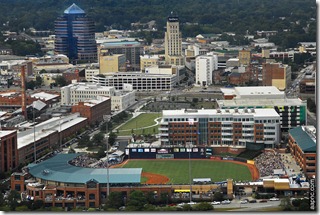In the early 1990s, downtown Durham was well into its second decade of a nearly four decade run-up to revitalization. Through fresh “demand side” eyes, you could already see then what is very apparent today.
Yes, contrary to myth, downtown was not on life support when I arrived in 1989 to jump-start the “demand-side” visitor-centric economic and cultural development for Durham as a whole, the specialty from which I retired some years ago after almost four decades.
Nor was a “DNR” order in place for downtown when Durham’s fledgling “supply side” downtown advocacy group made an inspired choice for an executive five years later. Both of us are now retired and have been replaced by possibly even more inspired choices, each facing a more sophisticated if not transcendent challenge.
“Demand-siders” by necessity see the glass as “half full” while those in the more developer-driven “supply-side” of economic development have a propensity to view the glass as “half empty.”
The former must be change-driven but reassuring by nature, the latter must often manufacture a sense of urgency to motivate action. At a minimum, passion should be a job requirement for either.
Both types of economic development organizations are subject to pejoratives. “Demand-siders” are stereotyped as just “tourism,” although that is only the means to far more pervasive ends. To economists, the “demand-side” is one of the only sure-fire means to true economic value-added.
“Supply-siders,” including governments contracting with chambers of commerce and downtown organizations are often dismissed, to adapt from insiders such as Dr. Ron Coan, as smokestack chasers, chip-chasers, data storage and cluster-innovation chasers and now talent and facility chasers to name a few.
A “demand-sider’s” job is to make the best of what’s there and spearhead the consumer demand and awareness that will enable the market to do its magic.
“Supply-siders” tend to be more “build it and they will come,” which a New York Times headline some years ago completed as “but not for long.” By this, inference was made that a matrix of facilities without community marketing is like “blinking in the dark.”
Even together, a delicate balance is required to avoid dislocation or diversion. “Brick and mortar” is a tactic not a strategy and best serves as a response to the market versus a stimulus.
The bane of a “demand sider’s” existence is that both elected officials and the majority of business leaders tend to more readily grasp “bricks and mortar,” the forte of “supply-siders.”
It is understandable. “Bricks and mortar” are more concrete and literal both as ribbon-cutting and as photo ops, but also as a constant visual reminder to voters.
By comparison, the “demand sider’s” tasks of changing behavior to fuel the demand that makes projects sustainable as well as to protect and promote a community’s sense of place are, while more measurable in a value-added sense, are also more subtle and conceptual.
The best of both worlds, is when both sides listen carefully to and leverage the expertise of one another and community leaders are respectful of both.
Both types of economic development originated more than a hundred years ago at the dawn of the Progressive Era but didn’t really begin to thrive on behalf of communities until they were un-joined at the hip, a movement that took hold in the 1960s and 1970s.
Communities and markets need both types of economic development but by their inherent natures, they each require and work best from opposite sides of the brain.
A sign of maturity, is the capacity to redirect requests from misguided, one-size-fits-all stakeholders back and forth among agencies on both sides of economic devolvement.
Both require “evangelists” but are best practiced with humility.
Left uninformed by the “demand-side” with its focus on distinguishing sense of place, fostering of place-based assets and creating “divergence” - “supply-siders” may be too quick to tear down, too comfortable with “churn,” addicted to “convergence” and driven to make communities the “same” vs. “distinct.”
A community needs both, and a little friction from time to time is good. But let “demand-siders” or “supply-siders” get too much of the upper hand or forget their respective roles and the result is the same.
Community homogenization and irrelevance.
No comments:
Post a Comment